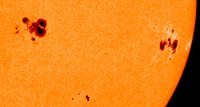|
Sunspots
The
@stro object for the week of 03/06/2000

image
courtesy of SOHO
Sunspots.
Sunspots
are large, dark, rapidly changing areas on the Sun's surface that
can be up to 50,000 miles in diameter. Sunspots usually only last
a few days, although they can last as long as weeks or months.
While the nature
of how they are developed is still a subject of research they are
believed to be caused by areas of high magnetic activity blocking
some solar energy from entering these regions. The blocking of this
energy results in colder temperatures than the surrounding photosphere
and the darker appearance.
Sunspots are
often used as a predictor of solar activity. The
number of sunspots increases and decreases on a fairly regular schedule.
The Sun's cycle is broken up into two phases: the "solar maximum",
which is the highest point of solar activity, and the "solar
minimum", which is the lowest part of solar activity. The length
of the solar cycle averages around 11 years from one solar maximum
(or minimum) to the next. Sunspots are at their lowest numbers during
solar minimum and at their peak numbers during solar maximum, in
direct correlation to this cycle . Currently the Sun is entering
a period of maximum activity.
Sunspots can
easily be seen with a small telescope or binoculars fitted with
proper solar filtering. REMEMBER:
NEVER LOOK AT THE SUN DIRECTLY WITHOUT PROPER SOLAR FILTERS IN PLACE.
Visit
the SOHO
site to view images taken in several wavelengths of light.
| Current
information for the Sun (North America): |
| Rise: 0628
PST |
| Set: 1802
PST |
| Magnitude:
-26.8 |
| Constellation:
Aquarius |
more
info from the Exploratorium...
more
info on the solar cycle...
more
info from APOD
|